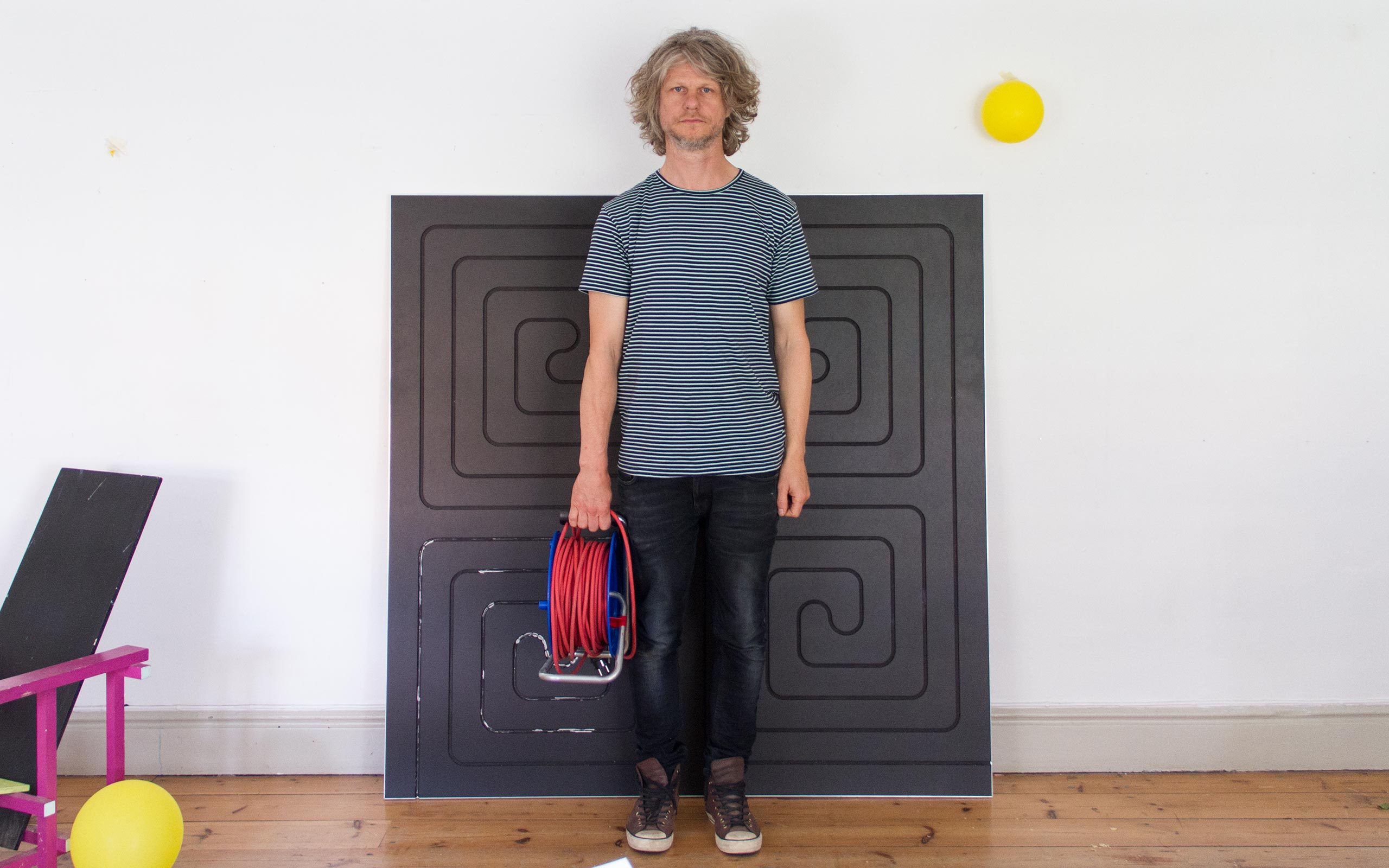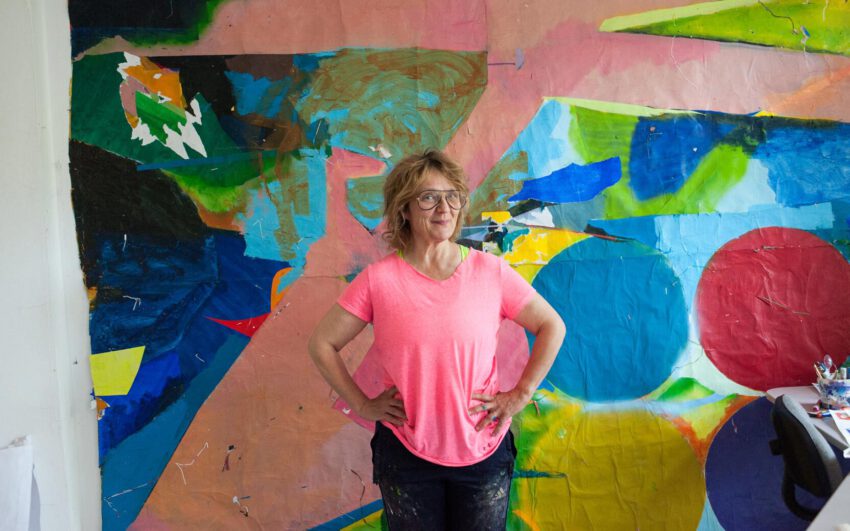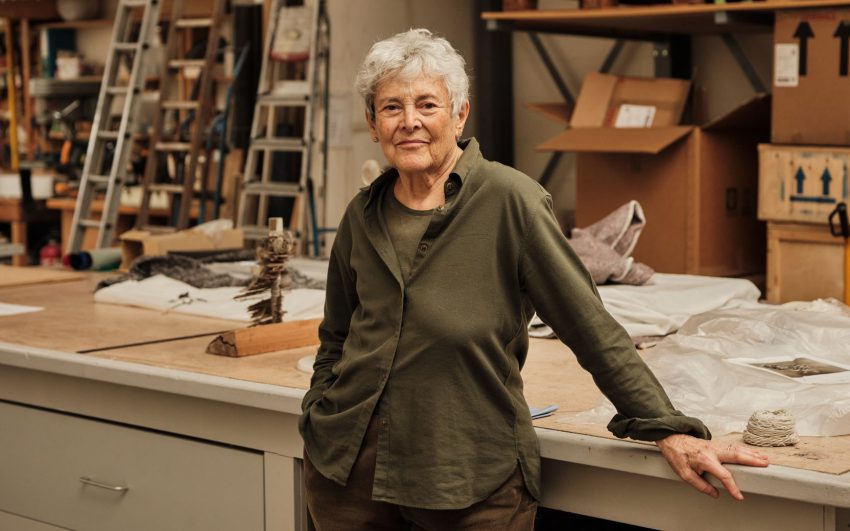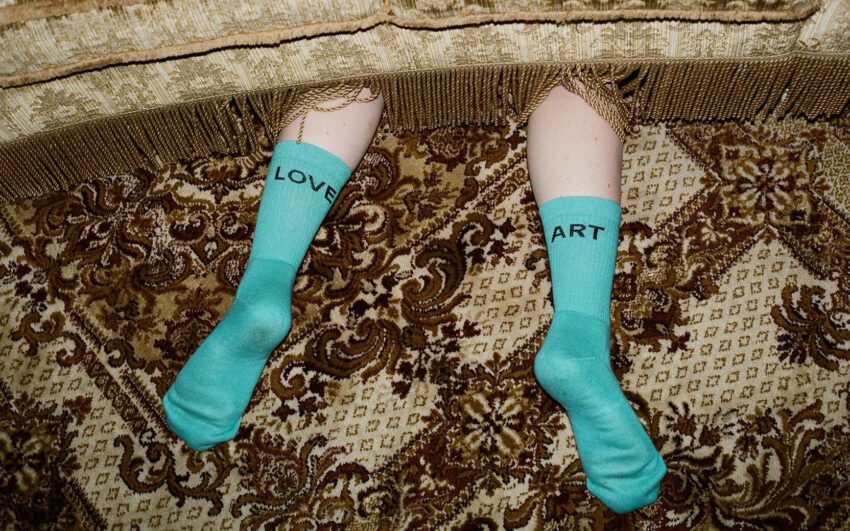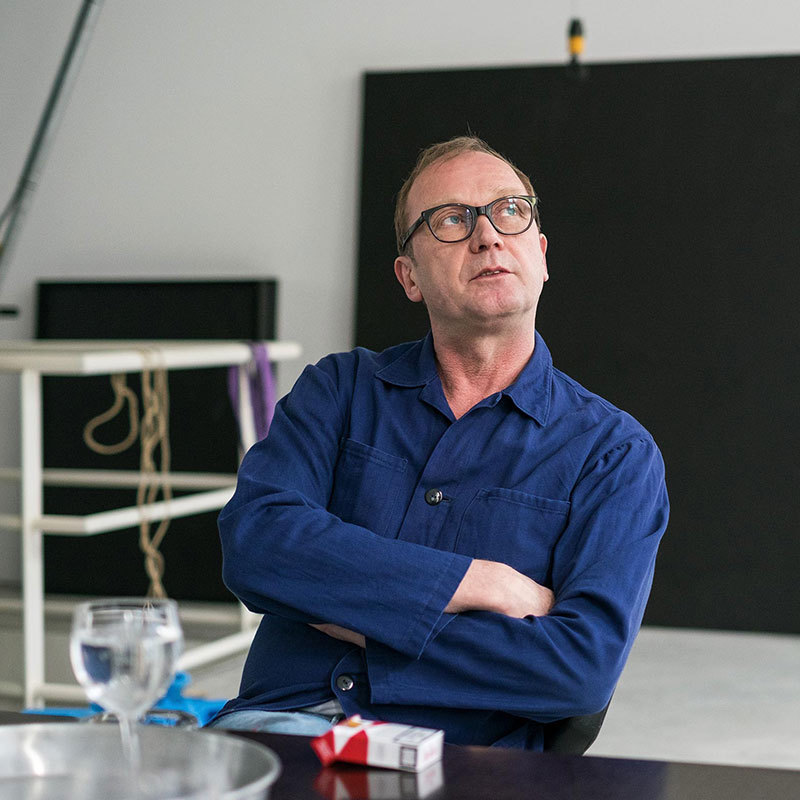The scene for contemporary art in Europe’s North is expanding and developing new dynamics as international collectors are watching the scene. With Nordic Notes we regularly cast the eye on the Nordic art and cultural scene, portraying its important actors.
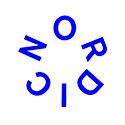
Attracted by minimalist tradition, Swedish artist Jacob Dahlgren finds abstraction in everyday objects and often overlooked details of contemporary life, which he employs to create dynamic interactive installations and performances. When arranged, the individual objects lose their intended function and form something completely new. Jacob makes reference to artistic styles of the 20th century such as Constructivism, Minimal Art, Pop Art, and the Op Art movement. An important theme in his work is how art and everyday life are intertwined. We met Jacob in his studio in Stockholm’s Södermalm district to talk about his work for the Venice Biennale, his gigantic archive of striped T-shirts, and why he occasionally gets kicked out in supermarkets.
Jacob, it’s impossible to avoid “stripes” when talking with you. So we might just as well start with it. Where does your obsession with stripes come from? Why not polka dots or something else?
To start with, I don't really care much about dots. (laughs) My fascination with stripes goes back to my time at art school, where I did a lot of Constructivist paintings. Without really noticing, I kept coming back to paintings composed of color fields. I tried out all kinds of colors and compositions, until I realized that I was getting a bit fed up with it. Which was when a friend told me “You know what, Jacob, you look like one of your paintings.” And it was true, because I loved to wear these striped T-shirts from the 1980s. After that I looked at my paintings differently. The T-shirt was a kind of continuation, outside the painting, which I found much more interesting. The painting itself became less important.
So that’s when you started looking at your shirts as pieces of art of their own?
Yes, by wearing one of my T-shirts I, or my shirt, would become the painting. So I started acting out more in the public space, away from exhibition spaces. Just as one assembles different paintings to create an exhibition I wore fourteen different T-shirts for fourteen days, taking off one each day, to create a performative exhibition. On day one I had to take my kids to kindergarten wearing fourteen T-shirts on top of each other, which got me a lot of strange looks by other parents. (laughs) The next step was to invite other people to create exhibitions by letting them browse through my archive of T-shirts and decide which I would wear next. This was before social media. I just asked people I came across in my daily life, anyone from the parents of my kids’ kindergarten to the director of a museum.
You are now running an Instagram and Pinterest feed with you wearing a different shirt in each picture. Is this a continuation of this earlier shirts exhibition you were just talking about?
Yes, one could say that the original exhibition has turned into a social media performance. The feed on my website updates itself every day. All pictures are cropped exactly the same format, so it's really nice when you put them together and flick through them.
You look a bit grim on these pictures… Is this intended?
I try to always look the same in all the pictures. Usually I look a bit unhappy, true, but I decided to put away all emotions, so that the focus remains on the alternating T-shirts. That way, the world is changing, and I am in the middle, just getting older.
You must own hundreds of T-shirts, if not thousands. How do you stack or store them?
I have 1,247 striped T-shirts at the moment, archived in my second studio. It’s actually more like a warehouse than a studio. All shirts are packed in boxes, ten in each box. And new ones are arriving all the time! I number and label them. On the label it says where I bought the shirt, what I paid for it, and so on.
And all of them are striped?
Of course!
Where do you buy them?
Everywhere. Sometimes people send them to me. Whenever I travel I try to find some new ones. I never buy online though. I don’t follow any fashion trends. I buy the ugly ones, too. In the beginning I was even buying women’s T-shirts as well.
Have you ever worn a collar shirt in your life? Would a striped collar shirt even be an option?
No, not since 2001. I even wear striped T-shirts at funerals and weddings.
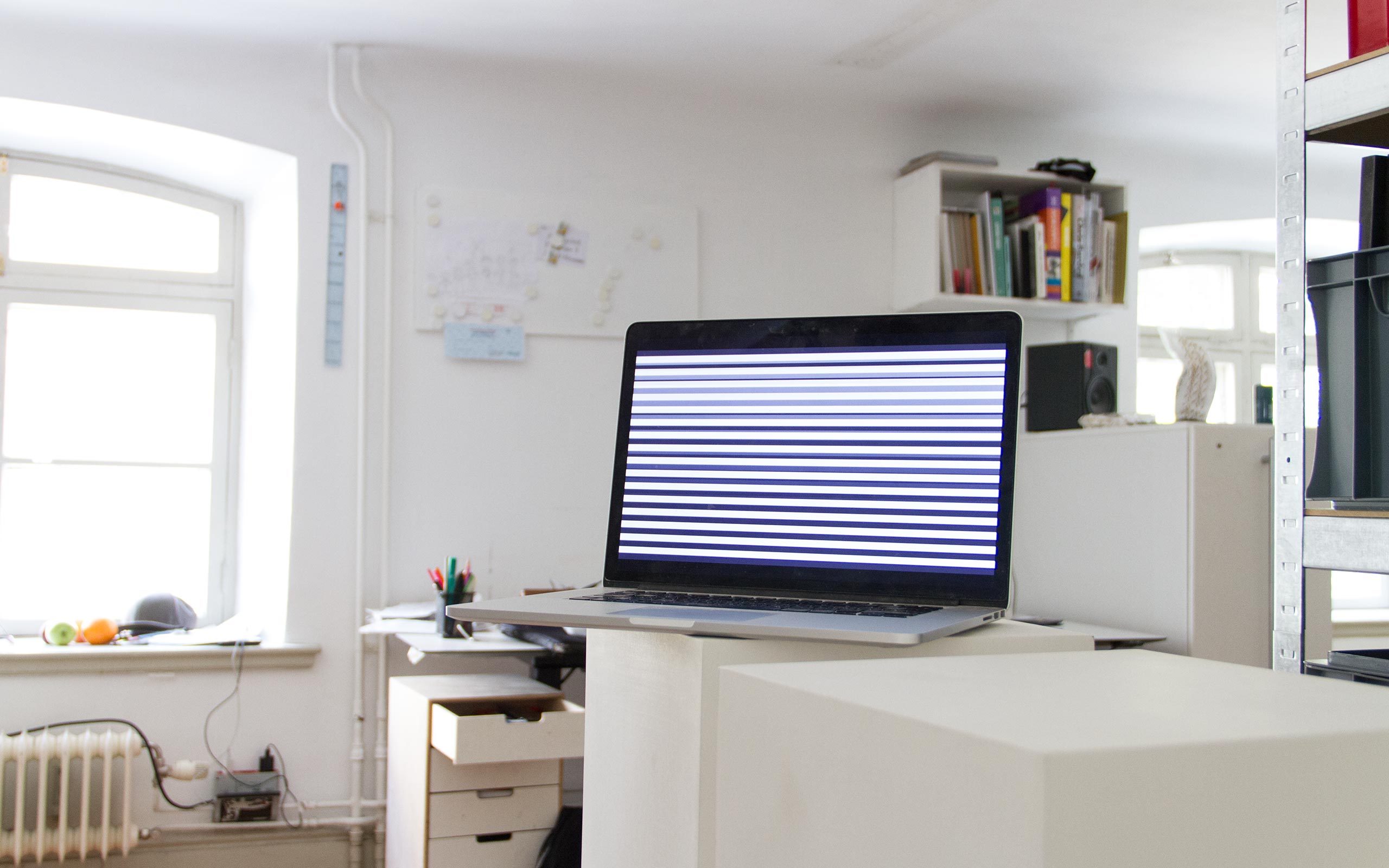
You have two kids. What are they saying about you wearing only striped shirts?
For a long time they thought it was really cool. And they used to be very proud of me, bragging to their friends about their dad. But at seven and nine my girls are now at an age where they are actually being ashamed of me I think. (laughs)
Have you completely left painting nowadays?
Oh no, I am still painting – in a way. But I very rarely use paint. At the moment I really enjoy working with untreated MDF boards. For this piece here I carved out an indentation, which works as a duct for 4-meter-long cable to form a pattern, a drawing if you will. Attached to the painting is a cable reel. You may plug the cable into a power socket and connect monitors to the painting. You may also connect it with another painting. So, rather than paint I have moved to making my paintings using objects. You know, I am quite interested in Minimalism and the Minimalist tradition. But it is important to me to make a connection to our daily lives. So I try to pair up Minimalism with objects of day-to-day use. This way, anything can be transformed into a minimal object.
And these objects are not tools to produce your work. They actually become the work?
Yes, I've always been interested in devices and tools to actually enter the work, rather than just being tools in the creation process. So, instead of using pencils for drawing, I would use the pencils as the material for the picture. I mean, a pencil is a pencil, but when you put multiple pencils together and organize them in a certain way, they become something else. I suppose I have an obsession with categorizing and organizing things.
Where do you find objects to produce new works?
You know, I can get really excited when I enter a supermarket, because everything in there could become the material for a new painting. It’s the same as stepping into an artist supply store and looking at a shelf with paint tubes. Sometimes I even make a sculpture in the supermarket. I put it up somewhere there and leave it there. It's perfect for trying things out and to see people’s reactions. Sometimes you get kicked out of course...
Really? But what are you doing that they kick you out? Is it more than just stacking some tins on top of each other?
Well, I am kind of reorganizing their shop. I've gone quite far sometimes…
Did the supermarket staff ever recognize who you are, and that it was an artistic act of yours? Or were they just seeing somebody vandalizing the store?
Just someone vandalizing the store. (laughs) In other cases no one says anything and store customers take items from it and, gradually, the sculpture disappears. I find it really interesting when people get involved in the work in different ways, when an interactive moment sets in.
So you really like your surrounding interact with your work?
Yes, absolutely. Sometimes I even let other people take the lead in the creation process, rather than letting them respond to the work. For example, for ten years I have been following people with a camera in different cities. Whenever I see someone with a striped T-shirt I follow the person until I get noticed, or until he or she goes somewhere where I cannot follow. What I like about it is that you are diverted from your own route. Sometimes I end up in a neighborhood I really am not supposed to be in. It’s a bit like stepping onto forbidden terrain. It’s perhaps comparable to the excitement of spraying a graffiti on a wall hoping to not get caught.
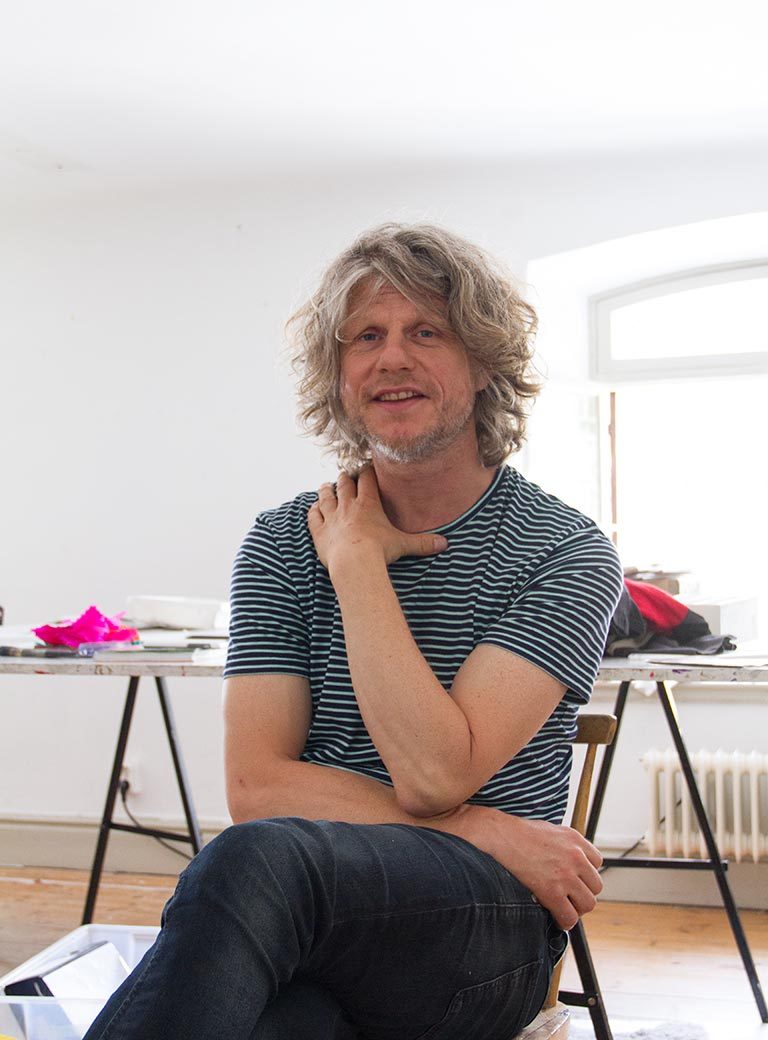
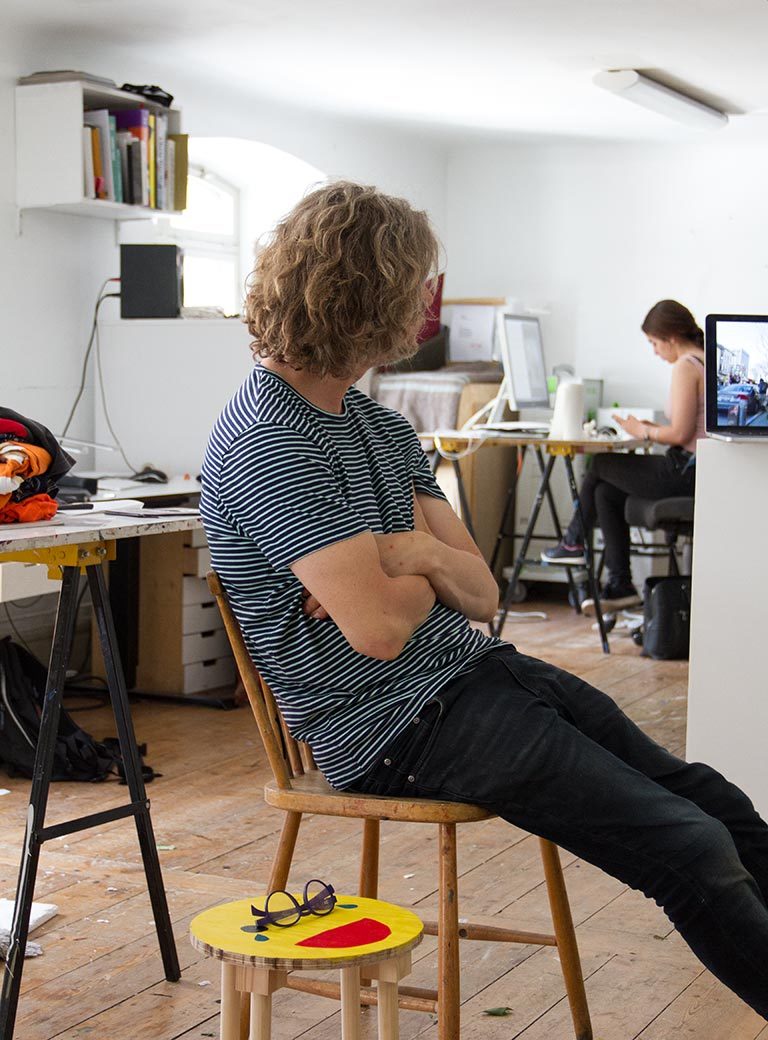
To someone to whom interaction between the viewer and the work itself is so important, has the internet given you new opportunities to stage such moments of interaction?
Yes, for sure. I use Instagram. It’s a perfect platform to continue my T-shirt project. I invite people to curate shows which use my T-shirt collection. They can choose from my digital database of archived T-shirts for a period of time, put a title for the show and write a short text. I post that together with the images of myself wearing the selected T-shirts.
In 2007, you represented Sweden with an interactive installation as part of a group show in the Nordic Pavilion at the Venice Biennale. Did this event impact your career as an artist?
Yes, it was an installation of concentric circles on a wall forming a psychedelic pattern, an allusion to Bridget Riley as well as Jasper Johns’s and Kenneth Noland's “target paintings”. Visitors were able to play darts with the wall, so it was a very interactive experience. Venice felt like a big party to me. It was a really good experience. Venice is very influential in terms of getting the word out. But I think the bigger change for me was three or four years earlier, when I started doing more interactive work, rather than sculptures and objects.
One of your best-known works is a sculpture of colored steel beams, reminiscent of Tetris blocks, which is installed in a forest in Southern Sweden.
Oh, I think you mean Primary Structure in the Sculpture Park of the Wanås Foundation in Northeastern Skåne. It’s is a beautiful estate including a castle in medieval Danish style, an organic milk farm, forests, pastures, and farmland. The Sculpture Park is open all year round. Every year, Nordic and international artists are invited to create art in the park, which is then shown between May and October. Many installations are site-specific and stay permanently. Wanås Konst acquired Primary Structure in 2011. It consists of 104 parts in eighteen colors. I enjoy seeing children climbing the installation, or even adults stepping inside it, because it is the interaction between body and object that I am interested in.
Talking about art institutions, do you actually like it when curators talk about and interpret your work, or would you rather like to explain it yourself?
I actually like it when viewers assume that role by themselves, because sometimes people come up with very bright ideas I didn't even think about. Most of the time, I can’t really talk well about my own work. It depends. However, if I am in the right mood and really start talking about my work it can actually be exciting. What’s important to me personally is to show people how art and everyday life are intertwined.
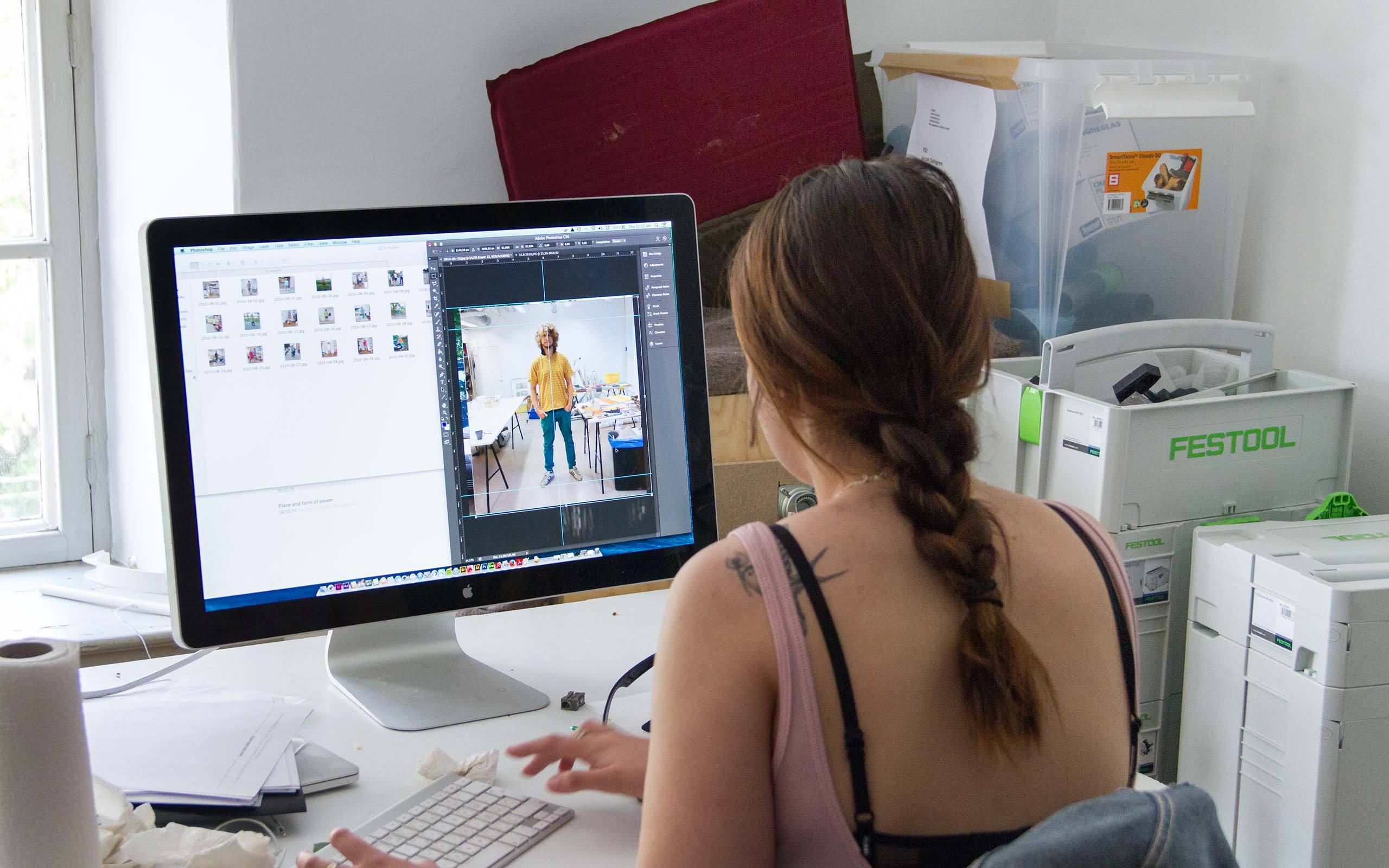
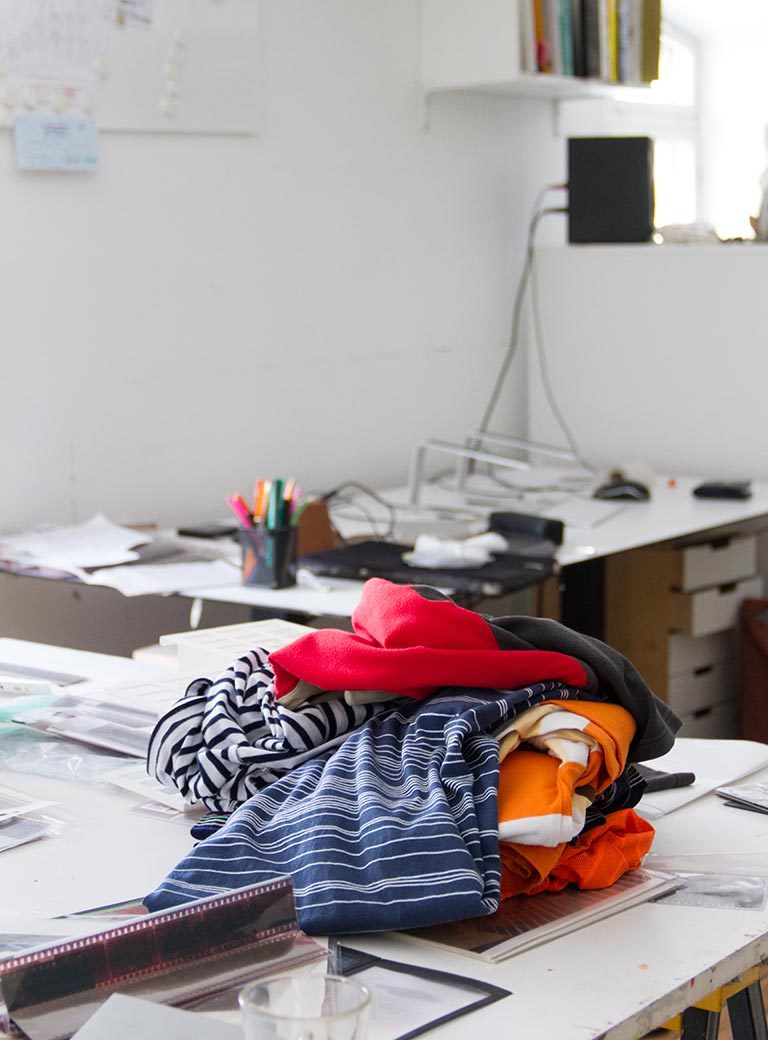
We would be interested to hear from you as an insider to the Swedish art scene, whether you see any topics or concepts that could be considered as “typical” for Swedish art?
I don’t know whether there is such a thing as typical “Swedish art.” If at all, I would refer to it as “art from the Nordic region.” People are traveling so much these days, including artists of course. Inspiration and impressions from different places spread really fast nowadays. So national specifics are dissolving.
But there is one quality, which I consider really typical for Swedes. We are generally very good in discovering and adopting things from different places, and turning them into something new. For example, Sweden does not really invent fashion, but it points the way for what becomes trendy throughout Europe.
In Finland there has been a very strong traditional Constructivist art movement, which spread to Sweden. Olle Baertling was a very important figurehead of Swedish Constructivism. He died in the early 1980s, but he still influences contemporary artists. I am a big admirer of his work. I was lucky to buy a piece a long time ago. Today his work is pretty much out of reach for most people.
Talking of the impact artists can make on others, do you think there is something an artist gives or should be giving to society?
Absolutely. I think it's really important for artists to open people’s eyes, to show them the beauty in our daily lives, or to point out political issues. It needs someone, in addition to journalists or TV shows, to make people think and look at things differently. I think that is a super important task for artists.
How is it for your two kids to grow up with a dad who is an artist? Do they understand what you are doing?
I believe they think that I have a proper job, because I leave home and work at regular hours. Time and again I go on business travels or prepare exhibitions. It’s kind of normal to them. But I think they get the idea of art. I mean, my kids have been a part of my work during all those years, interacting with my work, and sometimes helping me with it. I remember my daughter Nin looking at a round pink carpet in the toilet of a place we were invited to for a party. She said, “Dad, that is just a round pink carpet, it's not art.” I thought that was a pretty smart statement coming from a three-year old. Things just get complicated when they are introduced to art as a subject at school. I think the educational system is not helping children develop an uninhibited sense for art. It is all about limitations and boxes.
What are you working on at the moment?
At the moment I am just about to complete this painting with the cables. It will go to Berlin. I am also working on an exhibition at Museum Ritter, outside Stuttgart. And then I am working on a book entitled From A-Z which will be published by Garret Publications, a new Finish publishing house. It's really fun to get back to where you started, to see that you develop, and that you are still interested in the same things. Generally, I am trying to work more with my hands these days. I've been in front of the computer for too long… You can render perfect computer drawings but I appreciate the limitations and imperfections when creating something by hand.
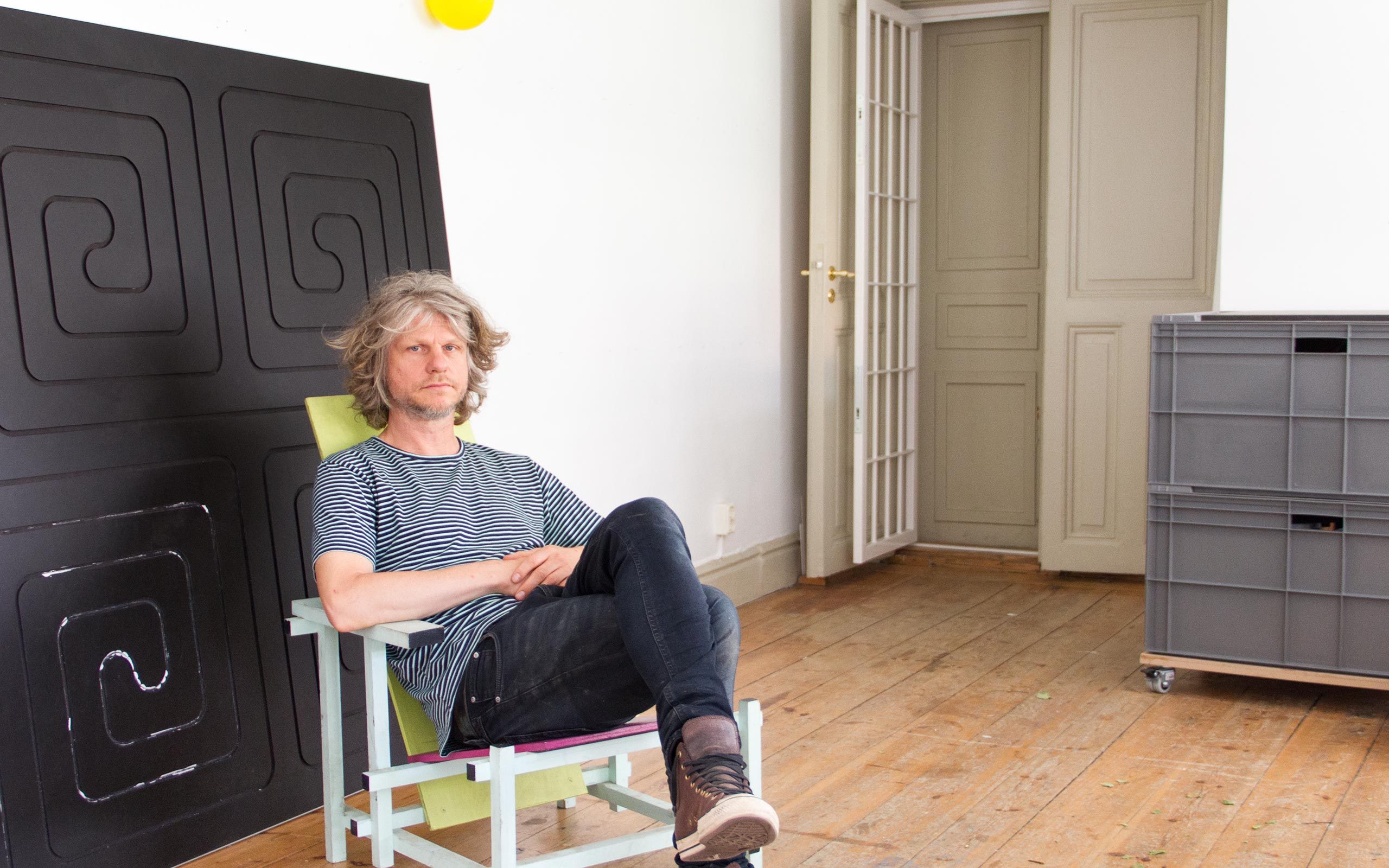
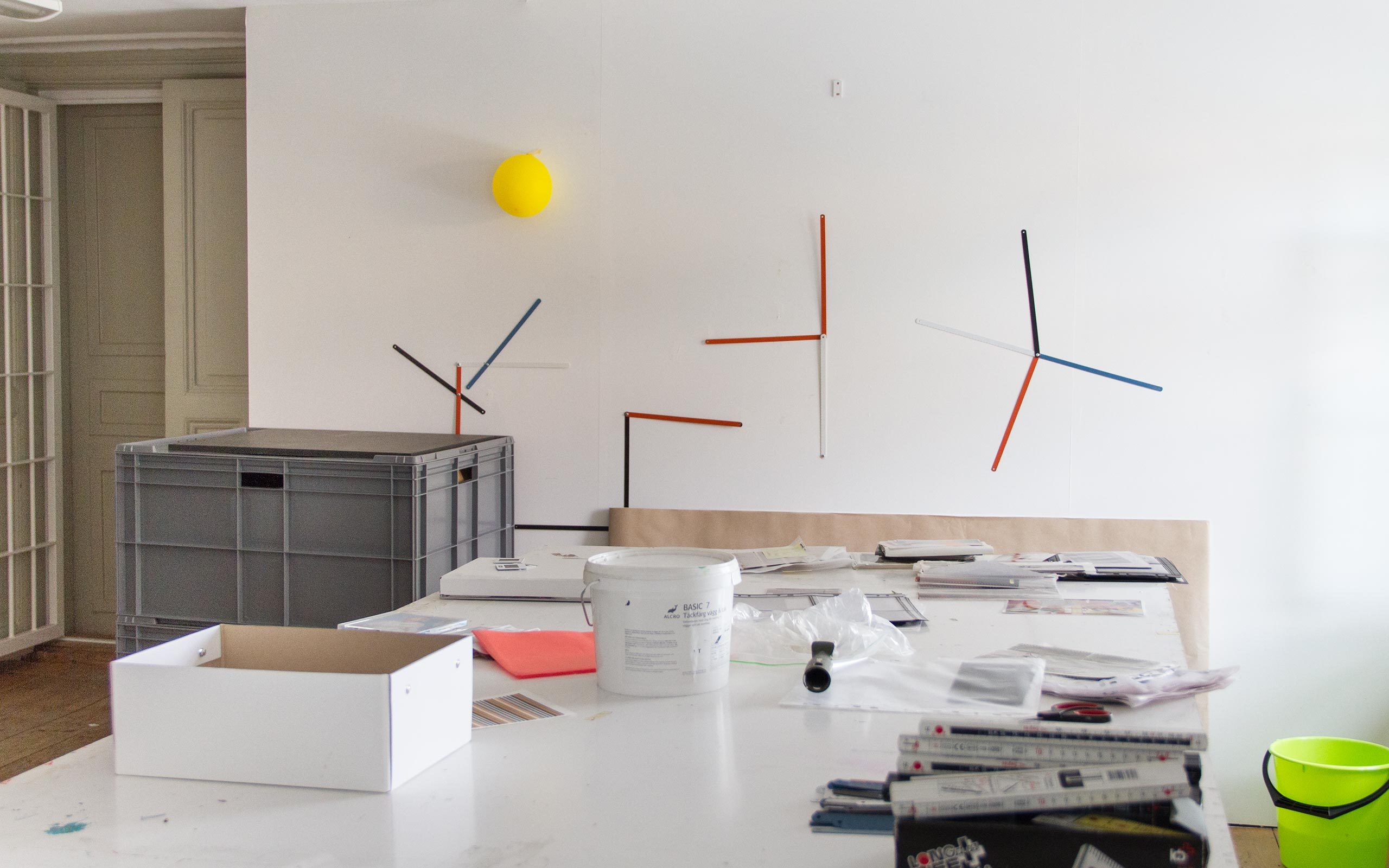
Interview: Michael Wuerges
Photos: Florian Langhammer


